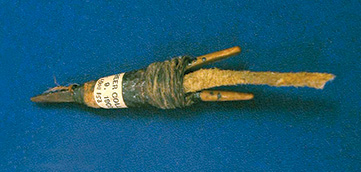Culture
British Museum loaning Tribe Summers Collection items for 2018 exhibit

By Danielle Frost
Thirty years is the amount of time that dozens of Tribal employees and representatives have invested in seeking the return of the Summers Collection to Grand Ronde.
On Friday, Nov. 17, just days before the Tribe’s 34th Restoration celebration, Historic Preservation Manager Briece Edwards and his staff received notification that the British Museum in London will grant the Tribe a limited duration loan of select items for a summer 2018 exhibit on collectors of Grand Ronde culture at the Chachalu Museum & Cultural Center.
The exhibit, “Rise of the Collectors,” also will include additional artifacts from other institutions and is set to run from June 2018 through May 2019.
For almost 20 years, the London museum has become a pilgrimage destination of sorts for individuals seeking to see and reconnect with belongings of their family and Tribe, Edwards said.
For instance, Tribal Council Chairwoman Cheryle A. Kennedy, then-Tribal Council Secretary June Sell-Sherer and two Cultural Resources staff members traveled to London in December 2002 to view the Summers Collection.
“This collection represents many things to many in the community,” Edwards said. “For some, it is an opportunity to see remnant examples of weaving, carving or other fabrication techniques in order to bring those traditions back into the community to keep them from being lost … The Tribe and its members have not forgotten these to be belongings made by and for the community, who have a unique understanding about their purpose and internalized significance.”
Cultural Resources Department staff from across programs will be working to develop the exhibition, which will include workshops, presentations, gathering trips and cultural classes connected to the belongings on display. Artifacts and belongings from Grand Ronde are located in Russia, Japan, England, France, The Netherlands, Canada and the United States.
The Rev. Robert Summers, a McMinnville Episcopalian minister, collected and purchased several hundred items from the Tribe and other Tribes when he lived in Oregon during the 1870s. He was a naturalist as well as a minister and maintained a journal with detailed descriptions of each item, creating a record of its history.
According to a blog by Native historian and Tribal member David Lewis, the Summers Collection contains artifacts, baskets, tools, pipes, bags and carvings, many of which are believed to be originals from the first Tribal members brought to the Grand Ronde Reservation in the 1850s.
The blog says that during his time in Oregon, Summers and his wife, Lucia, who was also a naturalist, traveled extensively to many other Reservations. They collected artifacts from Tribes, such as the Siletz, the Klamath and those in eastern Oregon, where they also collected from burial mounds. At Klamath, Summers was allegedly so determined to obtain a necklace that his wife literally traded the dress she was wearing for the artifact.
The collection was donated to the British Museum in 1900 after the items had been given to another missionary, the Rev. Selwyn C. Freer, and both Summers and his wife had died.
“In Summers’ journal, there is a piece of correspondence where he said that those items should go back to the Tribes,” Edwards said.
Although it has been extremely challenging for Tribes to have their collections returned -- a full return of items in the British Museum collection takes an act of Parliament -- the tide is beginning to change.
“The British Museum is starting to understand the significance of the items they have and returning them back to communities,” Edwards said.
Although the items that Grand Ronde will receive are on loan only for a year, it represents an important first step.
“It was really a joint approach that was an outgrowth of multiple conversations and conclusions of staff and Tribal Council,” Edwards said. “We took the approach that these are important for many reasons, and we are losing our connection to them and what they exemplify.”
Edwards said Tribal Cultural Collections Coordinator Veronica Montano performed a bulk of the work to secure the collection loan.
“We received word the Friday before Restoration and I was ecstatic,” Edwards said. “But part of that is having known there was a team on it.”
He also thanked Cultural Resources Department Manager David Harrelson, Cultural Collection specialists Sibyl Edwards and Nick LaBonte, as well as the Tribe’s Legal Department, Tribal Council and executive team.
“Awareness at the British Museum has also helped,” Edwards said. “So have relationships through the American Museum in New York. It helped with recognition with how important museum study and engagement is to the Tribe.”
Montano said she was “a little surprised” to receive word of the loan.
“I didn’t think we would get it the first time around,” she said. “But I am super happy we did.”
Requesting a loan can be extremely time-consuming. Specifically, the process has involved correspondence, submittal of documentation for use and display of the collection, and reporting on the status of the Tribe’s museum construction.
“One of the reports took eight months to complete,” Montano said. “Then it needed to be viewed, revised and updated, and reviewed again.”
Montano thanked everyone who has helped over the years.
“Rob Greene (Tribal Attorney) worked on this a lot,” she said. “A lot of back work has been done to make it successful.”
At the General Council meeting held on Sunday, Dec. 3, Kennedy recalled traveling to the British Museum to view the collection.
“When I saw and handled those articles, I could feel the presence of our ancestors in each one,” Kennedy said. “One was a pipe of many of our grandfathers. As I unwrapped it, I just felt like crying because no one had seen it for 150 years. … This loan is for us to celebrate and welcome back these important historical artifacts that embody the spirit of our ancestors.”
